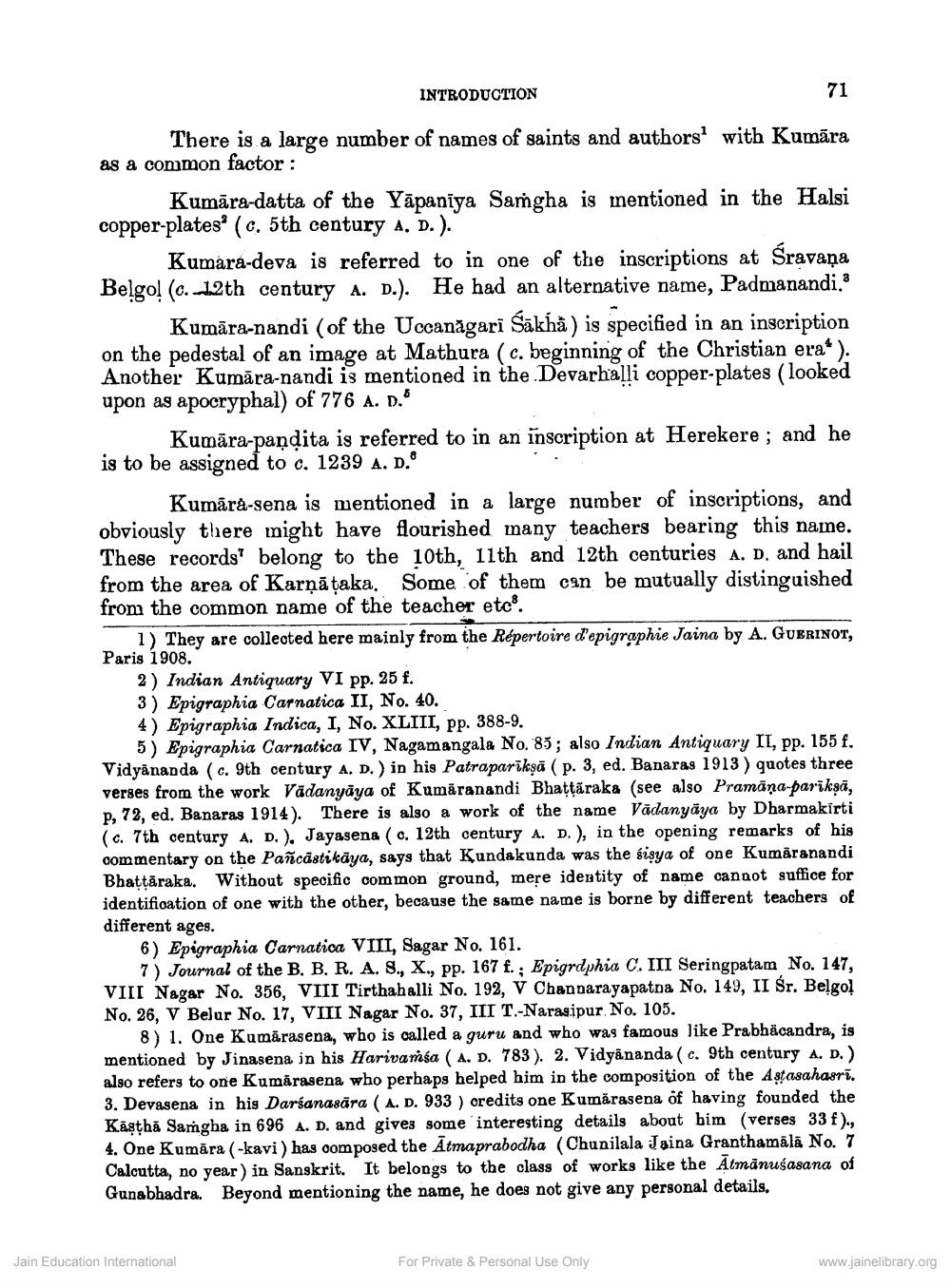________________
INTRODUCTION
There is a large number of names of saints and authors' with Kumāra as a common factor:
Kumara-datta of the Yapaniya Samgha is mentioned in the Halsi copper-plates (c. 5th century A. D.).
71
Kumara-deva is referred to in one of the inscriptions at Śravana Belgol (c.12th century A. D.). He had an alternative name, Padmanandi." Kumara-nandi (of the Uccanagari Sakha) is specified in an inscription on the pedestal of an image at Mathura (c. beginning of the Christian era*). Another Kumara-nandi is mentioned in the Devarhalli copper-plates (looked upon as apocryphal) of 776 A. D.
Kumara-pandita is referred to in an inscription at Herekere; and he is to be assigned to c. 1239 A. D.
Kumara-sena is mentioned in a large number of inscriptions, and obviously there might have flourished many teachers bearing this name. These records belong to the 10th, 11th and 12th centuries A. D. and hail from the area of Karnataka. Some of them can be mutually distinguished from the common name of the teacher etc.
1) They are collected here mainly from the Répertoire d'epigraphie Jaina by A. GUERINOT,
Paris 1908.
2) Indian Antiquary VI pp. 25 f.
3) Epigraphia Carnatica II, No. 40.
4) Epigraphia Indica, I, No. XLIII, pp. 388-9,
5) Epigraphia Carnatica IV, Nagamangala No. 85; also Indian Antiquary II, pp. 155 f. Vidyananda (c. 9th century A. D.) in his Patraparikṣā (p. 3, ed. Banaras 1913) quotes three verses from the work Vädanyaya of Kumaranandi Bhattáraka (see also Pramana-parikṣā, p, 72, ed. Banaras 1914). There is also a work of the name Vadanyaya by Dharmakirti (c. 7th century A. D.). Jayasena (c. 12th century A. D.), in the opening remarks of his commentary on the Pañcästikäya, says that Kundakunda was the sisya of one Kumaranandi Bhaṭṭāraka. Without specific common ground, mere identity of name cannot suffice for identification of one with the other, because the same name is borne by different teachers of different ages.
6) Epigraphia Carnation VIII, Sagar No. 161.
7) Journal of the B. B. R. A. 8, X., pp. 167 f.; Epigraphia C. III Seringpatam No. 147, VIII Nagar No. 356, VIII Tirthahalli No. 192, V Channarayapatna No. 149, II Sr. Belgol No. 26, V Belur No. 17, VIII Nagar No. 37, III T.-Narasipur No. 105.
8) 1. One Kumarasena, who is called a guru and who was famous like Prabhäcandra, is mentioned by Jinasena in his Harivamsa (A. D. 783). 2. Vidyananda (c. 9th century A. D.) also refers to one Kumarasena who perhaps helped him in the composition of the datasahari, 3. Devasena in his Darśanasara (A. D. 933) credits one Kumărasena of having founded the Kaṣṭhā Samgha in 696 A. D. and gives some interesting details about him (verses 33 f)., 4. One Kumara (-kavi) has composed the Atmaprabodha (Chunilala Jaina Granthamala No. 7 Calcutta, no year) in Sanskrit. It belongs to the class of works like the Atmanusasana of Gunabhadra. Beyond mentioning the name, he does not give any personal details.
Jain Education International
For Private & Personal Use Only
www.jainelibrary.org




